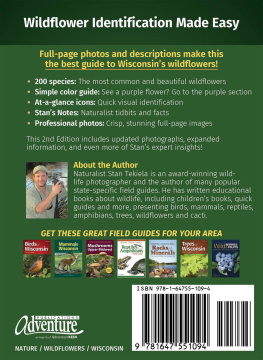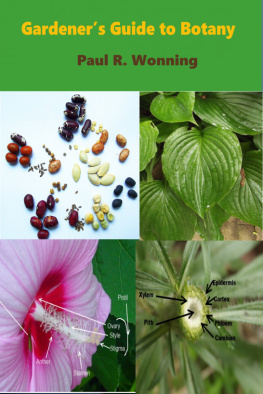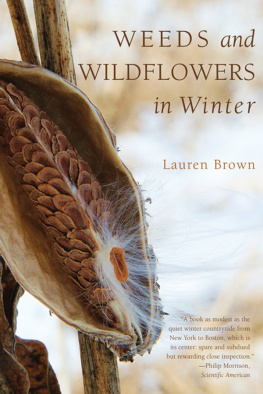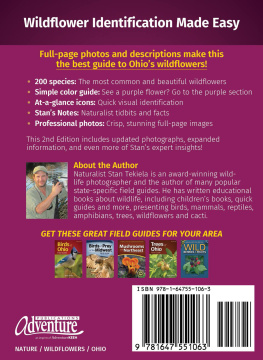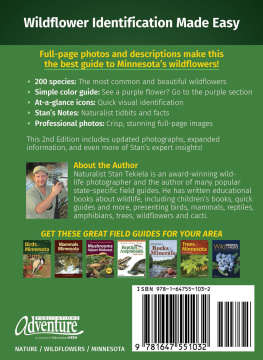

WILDFLOWERS of NEW ENGLAND
Ted Elliman & New England Wild Flower Society

Dedicated to my mother and
to the memory of my father.
: Lobelia cardinalis.
Copyright 2016 by Ted Elliman and New England Wild Flower Society.
All rights reserved.
Photo and illustration credits appear on .
Published in 2016 by Timber Press, Inc.
The Haseltine Building
133 S.W. Second Avenue, Suite 450
Portland, Oregon 97204-3527
timberpress.com
eISBN 978-1-60469-740-7
Cover design by Anna Eshelman
See the Library of Congress for CIP data.
A catalog record for this book is also available from the British Library.

CONTENTS

FOREWORD
The New England flora has been studied by botanists, both amateur and professional, for more than three hundred years, yet our knowledge of the regions plants continues to evolve as new species are discovered and others move into (or out of) our region. In 2011, the scope of our regions flora was compiled in the manual Flora Novae-Angliae, written by Arthur Haines and published by the New England Wild Flower Society. Writing a flora is a monumental work, but creating a field guide from that information presents additional problems for the author. Consider the following three issues:
1. How many. In a field guide it is impossible to cover all of the plants contained in a flora (that would make it too cumbersome), yet a guide should include those species that the reader is likely to see or should at least be familiar with. The reader is relying on the authors experience to present those species the reader may find (be they common or rare), and leave out others.
2. How to. What system of identification should the author use? Should a dichotomous key to all plant groups be included? Is it sufficient to rely on color photographs or drawings for identification? This gets to the heart of an educational debate on how to identify plants: rely on color or other easily seen characters requiring little or no botanical knowledge, or use botanical terms which may seem arcane, but once learned become part of the users vocabulary forever? While this may seem a small point, at the extremes the methods used can produce either a coffee table book or a functional field guide.
3. How much. The information presented about each species must be concise, but complete enough so that the reader can be sure the plant being identified is the one he or she thinks it is. The author also must present those characteristics of plants or habitats that are most important and/or interesting to both professional and nonprofessional plant enthusiasts without much space for elaboration. We want the field guide author to give us those little details learned over the years, those little hints that demonstrate the authors knowledge and command of the flora.
Luckily for the New England Wild Flower Society and plant enthusiasts in the region, Ted Elliman has balanced all of these issues beautifully in this field guide to New England wildflowers. His decades of experience with the New England flora have produced a book that is thorough and concise, as well as interesting to professional and amateur alike. Based on Flora Novae-Angliae, this field guide continues the Societys efforts to promote knowledge about native plants so that all may come to appreciate the plants that make up the biologically diverse landscapes across our region. As readers become aware of the astounding beauty and breadth of our plants, they will also come to value their conservation. I am sure that this book will be a catalyst for conservation of our flora.
Bill Brumback
Director of Conservation
New England Wild Flower Society
ACKNOWLEDGMENTS
I owe a great debt of thanks to many people who have helped in many ways with this book. The writing would have been far more difficult and much less enjoyable without their generous contributions of time, knowledge, and expertise.
At the New England Wild Flower Society, my colleagues Bill Brumback, John Burns, Elizabeth Farnsworth, Arthur Haines, and Dan Jaffe have provided many photographs, reviewed and commented on drafts, and helped immeasurably with their extensive knowledge of the wildflowers and natural communities of the New England region. Bonnie Drexler, former Education Director at the Society, has devoted a lot of time, thought, and energy into helping with the selection and organization of photographsmy thanks to her for her enthusiasm and persistence. Debbi Edelstein, the Societys executive director, has provided continuing moral and administrative support throughout the project.
Many others connected to the Society as staff, instructors, guides, volunteers, board or committee members, and certificate students have given very generously of their time, skill, and knowledge. For photographs, reviews of drafts, discussions, ideas, research, and much else, I am deeply appreciative of the kindness, contributions, and insightful critiques of Mimi Chandler, Frances Clark, Deb Fountain, Andrea Golden, Barbara and Charles Grunden, Sandra Henderson, Kelly Kerrigan, Bruce Patterson, Nancy Savage, Dick Snellgrove, Gray Wexelblat, and Betty Wright. Any errors of fact or interpretation are my responsibility.
For years its been a pleasure to work with the Massachusetts Natural Heritage and Endangered Species Program on many botanical and ecological field projects, and I am very grateful to past and present Program staff members Bryan Connolly, Melissa Cullina, Karro Frost, Jennifer Garrett, Paul Somers, and Patricia Swain for their knowledge, advice, guidance, and photographs, which have meant so much for this book.
My thanks too, for contributions both direct and indirect, to long-time colleagues in the field David Huang, the late Les Mehrhoff, Charles Quinlan, Kent Schwarzkopf, and Wang Zhijun.
My wife, Alice, has not only very patiently accommodated my preoccupation with this book over two plus years, she has also helped greatly in reviewing and critiquing manuscript drafts.
Many photographers have contributed images for the booktheir names are given on the illustration credits pages, but I also wish to acknowledge here their photographic skill, botanical acumen, and generosity. Many photographers spent a lot of time selecting and sending photographs with a particular eye towards what would work well for this book. My thanks to them all.
Juree Sondker and Linda Willms of Timber Press have been patient and skillful editors; I thank them for conversations, encouragement, prodding, and attentive reviews and critiques of the manuscript.
Finally, I want to express my gratitude for the friendship and support of the New England Wild Flower Societys Sanctuary Committee, with whom I worked closely for many years and because of whom this book became a possibility: Pam Durrant, Bruce Patterson, Doug Payne, Bonnie Potter, Jim Wickis, and the late Rob Held.
Next page

